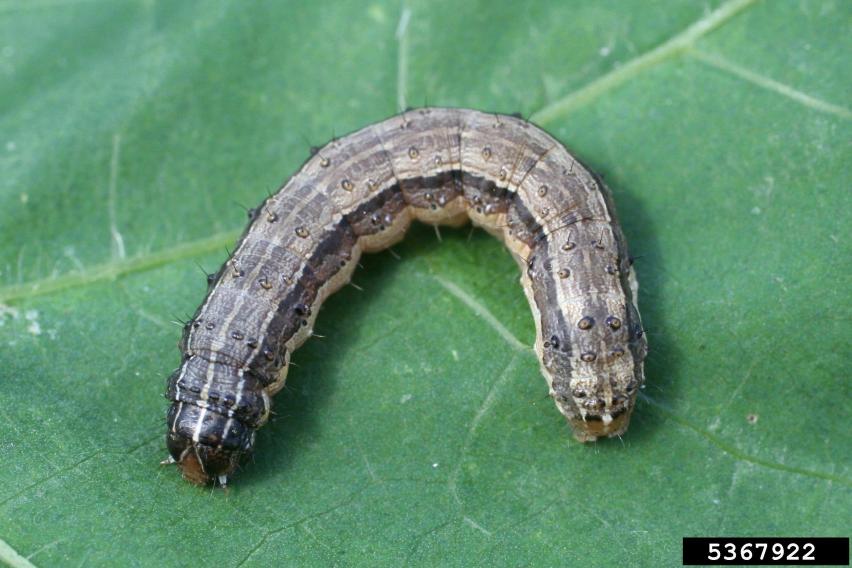Fall Army Worm
go.ncsu.edu/readext?821110
en Español / em Português
El inglés es el idioma de control de esta página. En la medida en que haya algún conflicto entre la traducción al inglés y la traducción, el inglés prevalece.
Al hacer clic en el enlace de traducción se activa un servicio de traducción gratuito para convertir la página al español. Al igual que con cualquier traducción por Internet, la conversión no es sensible al contexto y puede que no traduzca el texto en su significado original. NC State Extension no garantiza la exactitud del texto traducido. Por favor, tenga en cuenta que algunas aplicaciones y/o servicios pueden no funcionar como se espera cuando se traducen.
Português
Inglês é o idioma de controle desta página. Na medida que haja algum conflito entre o texto original em Inglês e a tradução, o Inglês prevalece.
Ao clicar no link de tradução, um serviço gratuito de tradução será ativado para converter a página para o Português. Como em qualquer tradução pela internet, a conversão não é sensivel ao contexto e pode não ocorrer a tradução para o significado orginal. O serviço de Extensão da Carolina do Norte (NC State Extension) não garante a exatidão do texto traduzido. Por favor, observe que algumas funções ou serviços podem não funcionar como esperado após a tradução.
English
English is the controlling language of this page. To the extent there is any conflict between the English text and the translation, English controls.
Clicking on the translation link activates a free translation service to convert the page to Spanish. As with any Internet translation, the conversion is not context-sensitive and may not translate the text to its original meaning. NC State Extension does not guarantee the accuracy of the translated text. Please note that some applications and/or services may not function as expected when translated.
Collapse ▲
Courtesy of Iowa State University
This year there have been several reports of fall army worms damaging pastures. As the name suggests, these pests make their appearance in the late summer or early fall. These insects can destroy a pasture in a very short period of time, sometimes with the damage seeming to occur overnight.
They feed on the leaf blades of pasture grasses, leaving behind only tough stems. This defoliation can stress and weaken pastures, leading to brown patches in the field that can rapidly increase in size. This damage reduces hay yields and forage available for grazing. They often travel in waves, searching for new forage.
Scouting for the fall armyworm is important, as they can very quickly become a problem. Be on the lookout for small striped larvae that range in color from light green to almost black. They have a distinctive “face” marking that looks like a light colored inverted “Y”. These larvae feed for about 14 days before pupating into the adult moth. The last four days is when they eat the most and can do the most damage. In order to scout for the armyworm, look closely at the ground and ruffle the grass to dislodge any armyworms. Count the number of larvae within a square foot area. Do this at multiple sites throughout the field. If you average more than 3 caterpillars that are ¼ inch or longer per square foot then you have reached the threshold for treatment.
In addition, you can look for the typical warning signs of an infestation. When the larvae are small, they start by eating the underside of the leaves without eating all the way through, leaving the clear epidermis intact. This leaves a translucent patch on the leaf blade, usually by the tips. This can create a pale frosted appearance to a field in the early stages. Knowing what to look for can save a hay cutting.
Treatment for fall armyworm in pastures can include spraying or simply harvesting hay before the armyworms consume it all. If you decide to harvest in response to an armyworm infestation, make sure you do so immediately and that you have good hay making weather. If you wait a couple of days the armyworms will harvest your field for you. It only takes them a few days to leave a field barren. Products that are approved for pastures can be found in this publication from NC State. Always be sure to read and follow all label warnings and directions.
Don’t wait until your grass is gone before deciding to do anything. Scouting frequently and taking quick action can help save your pastures and hay fields this fall.




